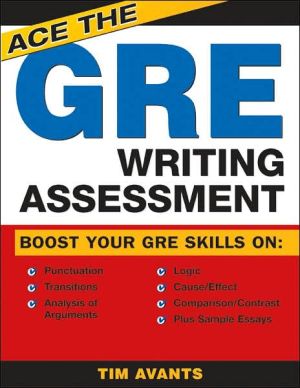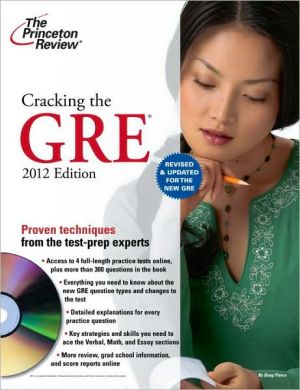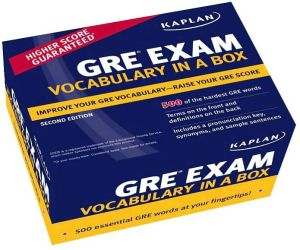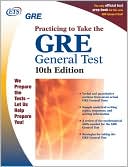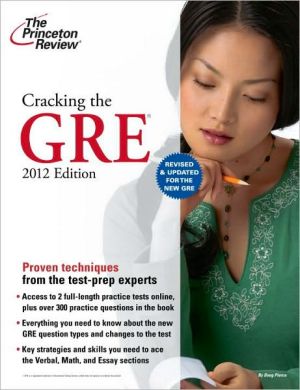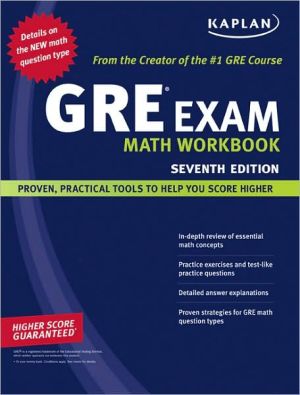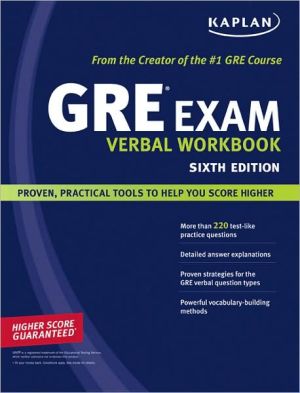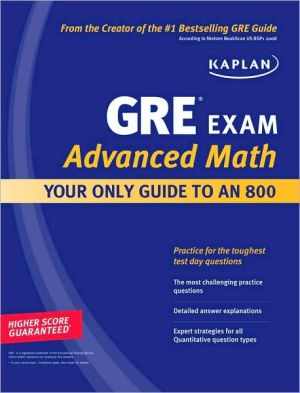Ace the GRE Writing Assessment
If you're one of the 500,000 students who will take the GRE this year, you know the stakes are high. Your score can determine whether you get into your ideal school-or settle for second-best. And the Writing Assessment is the hardest part of the test-one that trips up many students.\ Ace the GRE Writing Assessment gives you simple and clear instruction on what you need to know to score well on the toughest section of the test and provides real essay samples that you can relate to. You'll get...
Search in google:
If you're one of the 500,000 students who will take the GRE this year, you know the stakes are high.
Analysis of Argument\ The successful analysis of an argument depends on one's ability to recognize patterns in a written piece. Usually, in formal writing, an author develops an argument by using a specific method to write an essay. These methods are called patterns of development. Although numerous patterns exist, the GRE arguments you analyze will probably be written in the patterns of development below. This is good news, because you basically have three steps: First, to recognize the pattern of development; second, identify the flaw in the argument, and finally, analyze the flaw.\ Before we look at the patterns of development, beware of the following definitions. "Argument" simply refers to persuasive writing. Writing argument, then, means that a writer is trying to convince the reader to believe something. In addition, the term "flaw" in this context is equivalent to a weak point in a writer's logic or in his pattern of development. The test-taker must identify the flaw and write about that. However, a flaw may not actually be in a writer's argument. You can address the coherence in one's argument if you agree with what you read. Let's look at the patterns of development.\ Patterns of Development Comparison-Contrast-The features or benefits of two items are analyzed, perhaps with particular emphasis on how they differ. To compare is to discuss likenesses, and to contrast is to mention differences.\ Definition-The definition pattern usually includes a popular idea of what something is plus one's (the author's) personal concept. Sometimes, this pattern is called "extended definition," because the author goes past the normal idea of what something is (or isn't) to include a personal definition, as well.\ Cause-Effect-The cause-effect pattern can be difficult to recognize at times in that one could simply discuss the effect of something without giving due thought to how a situation developed over a long period of time. For example, one could make a blanket statement such as "Racism exists predominantly in the South due to the higher presence of ex-slave-states there as in contrast to the North." Although this statement may be partially true, the flaw in the argument surfaces, because the writer fails to address other factors that also had a significant influence in the growth of racism in the South. This is what you as the test-taker need to write about. Remember this: If the cause-effect pattern exists, but it is hard to recognize, the writer has failed to make logical connections from beginning to end. That causes a logical fallacy. We'll see those below shortly.\ The patterns of development require certain elements to formulate a coherent argument. Without coherence, the points seem to fall apart and the whole argument falls short of persuasion. Yet, at times, an argument may seem to be convincing. Our job as readers is to find the weak spot in the analysis. This is where logical fallacies come in. A logical fallacy is something that appears to be true but in reality is not. An argument based on a logical fallacy is actually based on a flaw.\ Logical Fallacies Non Sequitur This Latin phrase means "does not follow." Usually a conclusion does not match the statements before it, or the data does not support the conclusion.\ John loves children; He would be a good teacher.\ John's love of children does not mean that he would be able to communicate effectively.\ False Analogy An analogy is a comparison of two things that have some sort of similarity, but are dissimilar in other respects. A false analogy is flawed, because it assumes similarity in most other respects. This is where the phrase comparing "apples and oranges" comes from.\ If we can build weapons of mass destruction, we should be able to wipe out disease.\ Building weapons of mass destruction and wiping out disease are both situations rooted in science, but the obstacles faced with overcoming disease are entirely different from those of building weapons.\ Either/Or Fallacy The either/or fallacy oversimplifies a complex situation to a two-sided argument. Usually, the writer draws a line whereby the reader must accept all or none of the reasoning the writer sets forth.\ The government has two choices regarding the budget for next year: either cut the defense spending or people will go hungry.\ The either/or fallacy creates a false dilemma. A problem with many alternatives is usually reduced to only two choices.\ Circular Reasoning The conclusion and the support are the same with this logical flaw. The supporting evidence should lead to a logical conclusion, but, with circular reasoning, the conclusion simply restates a claim or the evidence.\ A genius has a high IQ, because he is smart.\ The second part simply restates the first.\ Begging the Question This type of fallacy is built on a supposition. The foundation of an argument is hypothetical. These fallacies are fairly easy to spot, because they start with phrases like "Let's suppose. . . " or "If x is true, then we could say that y would follow. . . ." You should attack these in argument questions.\ Ad Hominem This phrase literally means "toward the man." It is a ploy to deflect attention away from an issue by attacking its supporter.\ Senator John Doe's tax plan will fail, because Senator Doe admitted to adultery.\ The attention to the tax plan is drawn away and directed toward Senator Doe. Senator Doe's adultery is not relevant to the tax plan.\ Bandwagon Appeal This device appeals to the reader's sense of belonging, claiming that one should buy into a certain idea because of its popularity. In other words, if 70% of the people believe something, it must be right.\ 70% of the people surveyed agree that Brand X is the best drink in America.\ This is a tactic that tries to make a person feel alienated if s/he disagrees with an issue or an argument. Most often, public opinion is involved in the statement.\ Hasty Generalization This is the same thing as stereotyping. It involves lumping a group of people into the same category because of the characteristics of a few.\ Math majors are geeks, because my friend was a math major and he was the biggest geek I have ever known.\ The hasty generalization is certainly not limited to people, but it can also include any type of unfair categorization.\ Inductive vs. Deductive Logic Deduction and induction are two methods of presenting evidence in an argument. Deductive logic deals with a supposition that makes a statement and then leads away from it. Induction states many small points and brings forth an answer. The distinction in the argument essay is very clear: The deductive argument generally relies on a leap of faith that is not supported by enough evidence. So, when analyzing the argument, you should look for a flaw in the jump or the leap from the evidence to the conclusion.\ Overweight people are normally the ones in danger of having heart disease. Tom is a slender man. He is not in any danger of having heart disease.\ The first two statements may be true, yet the conclusion relies on a huge leap of faith. For all we know, Tom could eat three pounds of saturated fat per day. If the conclusion were to read "Tom may not be in danger of having heart disease if he leads a healthy lifestyle," then the conclusion matches the first two statements. The conclusion was qualified by the last clause and so the logic is not flawed.\ Look closely at the argument and the wording the question employs. Ensure the reasoning is sound. If not, focus on the errors of the argument when you address the statements.\ The inductive argument is the basis of scientific reasoning. Numerous points lead up to a conclusion. For the short essay, inductive logic works best. Whether you are analyzing an error in logic or a well-constructed argument, you should always first address the argument through your thesis statement. Then, your support should be stated in. the body. Analysis of sample questions is certainly crucial at this point.\ Sample Argument Questions and Essays Argument:\ "Previous experience has shown that soldiers' wives are happiest in areas where residents are highly concerned with leading lives built around the family. We should therefore build our next new military base in a suburb, which has many such residents. Many suburban merchants report that sales of family oriented recreational vehicles are much higher in suburban areas than in metropolitan areas. Further, most often children from a military family tend to join the military like their parent(s) did before them.\ Answer:\ The conclusion that the next new military base should be built in a suburb is based on inadequate evidence. The writer has a gap in his logic where he supposes that soldiers' wives would be happier living in a suburb than they would be living in a city. His conclusion does not follow his supporting statements.\ The author makes two specific errors in his reasoning. Primarily, he stereotypes the people in the city by indicating the wives are happiest in a family-oriented area (No mention of suburb was made). Immediately afterward, the writer claims, "We should therefore build. . .in a suburb." To say that the government should build in a suburb in order to make the wives happy suggests a couple of things. It says that if the wives are happy, the husbands, who presumably are the soldiers, will be happy, as well. The way the statements are set up also implies that suburb would be the most likely place that the wives would be happy and vicariously then the husbands would be happy, too. These implications go a step further: they suggest that city people are less happy, do not build their lives around their families, or do not care for their families as much as suburbanites do. That sets up an either/or logical problem, in which case the reader is pushed into accepting one alternative or the other. Here, the alternatives would be either to build in the suburb as. suggested and therefore be happy or be unhappy with any other possibility. In any of these situations, the writer's points fail. He gives inadequate support to make any of these assumptions. The only evidence given in support of the writer's suggestion to build in the suburb regards the sales of recreational vehicles. Higher sales of family-oriented recreational vehicles in suburban areas could be attributed to many factors. For example, maybe costs of recreational vehicles are cheaper in the suburbs as opposed to the cost of the vehicles in metropolitan areas. In fact, suburbanites could even go to the suburbs to buy these vehicles, and that could cause the rise in sales. So, these figures could be misleading. Likewise, the term recreational vehicle may even refer to things like motorcycles, three wheelers, dune buggies, and mini scooters, the likes of which one almost needs to be in the country to be able to drive. Many factors influence these types of figures. Some final comments are in order.\ One cannot conclude that people may be happier in the suburbs simply because recreational vehicles sell there more frequently than in the metropolitan areas. The logic is flawed. In addition, the writer has set up two groups of people that are not necessarily in opposition to each other: the city people and the suburbanites. Overall, the reasoning overlooks some vital information, and that destroys its soundness.
Contents Introduction to the Writing Assessment Punctuation Transitions Analysis of Argument Patterns of Development Logical Fallacies Inductive vs. Deductive Logic Sample Argument Questions and Essays Analysis of Issue Comparison-Contrast Sample Patterns of Development Comparison-Contrast Cause-Effect Division-Classification Sample Paper Definition Sample Essay Questions and Answers Epilogue
